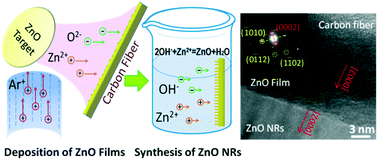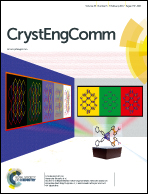Improvement of bond strength between ZnO nanorods and carbon fibers using magnetron sputtered ZnO films as the interphase†
Abstract
Grafting different kinds of nanomaterials on the surface of carbon fibers has been a feasible strategy for fabricating novel advanced materials. However, the bond strength between the nanomaterials and carbon fibers is a major challenge that limits the final properties of the materials. In this study, ZnO nanorods (NRs) were synthesized in an aqueous solution over ZnO films, which were deposited using a radio frequency magnetron sputtering technique. The experimental conditions for the magnetron sputtering process were designed based on an orthogonal test, and the ZnO islands exhibited different shapes and sizes under different deposition conditions. ZnO NRs, which were synthesized on all ZnO films, present the same hexagonal prism shape. In addition, TEM images show that ZnO NRs, ZnO films, and graphite structure of carbon fiber present a lattice matching that makes it possible to achieve an ultra-high bond strength of ZnO NRs. The results obtained for interfacial shear strength show that the bond strength of ZnO NRs is strongest when deposition time, substrate temperature, pressure ratio of Ar and O2, and power are 60 min, 200 °C, 0.15, and 200 W, respectively. We demonstrate that the higher crystallinity and uniformity of ZnO films result in a better bond strength of ZnO NRs.



 Please wait while we load your content...
Please wait while we load your content...